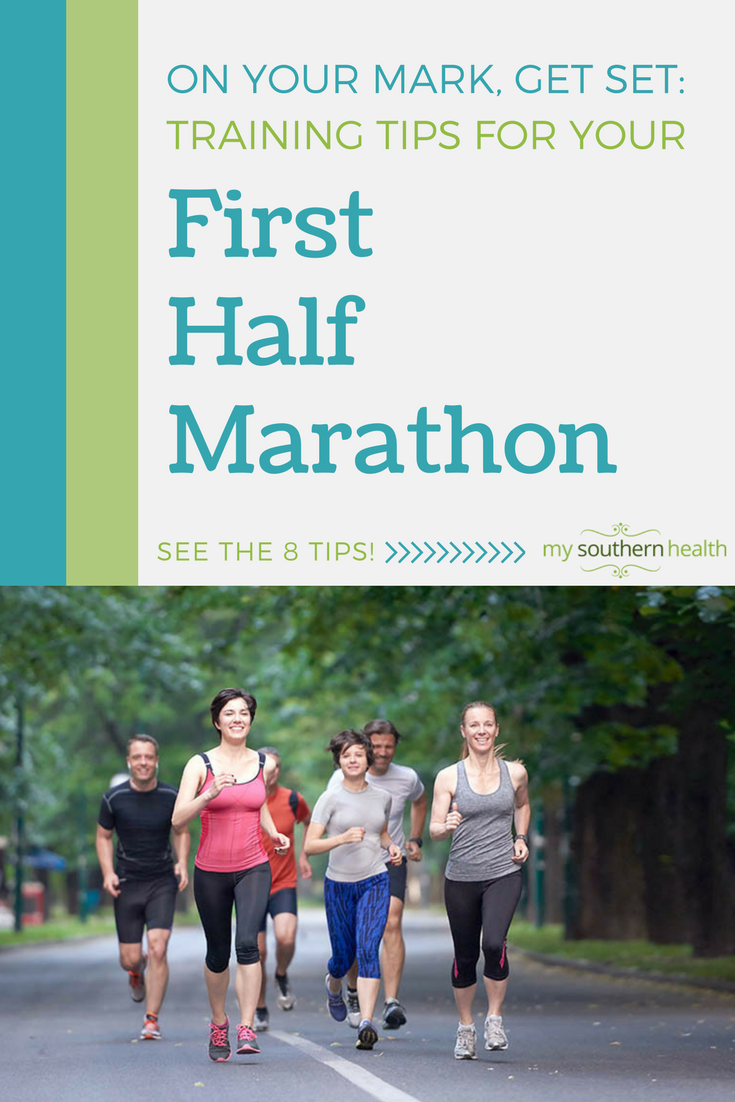Step up to the starting line prepared to go the distance in your first half marathon.
If you’ve already run a few 5Ks and a 10K, a half marathon may seem like a logical and challenging next step. The half marathon has become a popular running distance in the past few years. According to a 2013 article in Runner’s World magazine, the half marathon was reported as the fastest growing standard distance among U.S. road races. In fact, half marathons are becoming the most preferred race for both genders according to Running USA’s 2015 National Runner Survey, with more than 40 percent of participants indicating that half marathons were their favorite distance.
Is it the shorter distance, relative to a full marathon? Less time commitment? Whatever the reason, completion of a half marathon is an admirable accomplishment.
I’ve run more than 30 half marathons, and although I am not fast and have only occasionally placed in my age group, I have learned a thing or two from participating in them. While I often learned by doing things right, I have to admit that I gained some of my knowledge by making mistakes. If you have been inspired to run a half marathon, here are a few of my personal tips for success:
- Don’t skimp on the most important equipment you need: running shoes. Proper shoes are necessary for support during running and play an important role in injury prevention. I recommend going to a credible running store, with staff who are runners and know how to fit your feet. It is ideal if they can check your running gait. There are essentially three main categories of running shoes:
- Neutral: These shoes are for the runner with higher arches, a lighter body frame and an efficient running gait (i.e., no excessive outward or inward rolling of the foot).
- Stability: These shoes are designed to help prevent excessive pronation (inward rolling of the foot), by providing a little more ankle and arch support.
- Cushioned: These are generally recommended for heavier runners who need extra cushioning to help stabilize their ankles and control pronation. The best way to determine the type of shoe that is a perfect fit for you is having your running gait assessed by a shoe specialist. Performing your own “wet test” is another option. Runner’s World magazine provides easy step-by-step instructions.
- Choose a plan to follow. There are numerous running plans that map out weekly mileage and rest days, and can ultimately help you reach your goal. Runnersworld.com is perhaps one of the most trusted sources for do-it-yourself schedules. Some plans include walk/run schedules, while others provide beginner, intermediate and advanced programs. There are also group training programs available through local running stores, as well as programs where you can find sponsors and raise money for charities in exchange for expert support. The Nashville Striders running club is a local group that offers half marathon training programs, fun runs and course maps as well as lots of other information related to running that I find very helpful. Keep in mind that the plan you choose will help ensure that you don’t over-train, but also cover enough base mileage and engage in a few longer runs to be successful. Steer clear of any plan that offers limited to no flexibility on days when you don’t feel your best, are working late or need to make adjustments of any kind. Flexibility helps ensure success.
- Eat right for optimum performance. Eating a healthy, balanced diet is one of the most important ways in which you can ensure the best performance possible during training and on race day. Aim for making all of your meals and snacks during training as nutritious as possible, including lots of fresh fruit and vegetables, lean protein sources, whole grains and low-fat or fat-free dairy. Optimal pre- and post-workout snacks include both a carbohydrate and protein, such as apples and peanut butter, dried fruit and nuts, or yogurt and a piece of fresh fruit. Consider keeping a journal or logging your food intake with a phone app to determine the type, amount and timing of pre-/post-workout meals and snacks that work best for your peak performance training. Also, don’t wait until race day to experiment with your food intake, as you don’t want to experience unintentional stomach distress.
- Hydrate before, during and after your run. Adequate hydration can be the difference between success and failure on race day. Running in hot, humid conditions like we have in the summer Tennessee months calls for extra attention to fluid intake. Dehydration can not only hinder performance, but it can also increase body temperature to dangerous levels, leading to heat illness or heat stroke. The best way to determine hydration status is to check the color of your urine. It should be light in color, like lemonade. If it is dark, drink more fluid, as this indicates dehydration is likely. Drink extra water the day before a long run, along the training course, and throughout the day after a long run to replenish water lost through sweat. For short runs, water is recommended. If you are training for more than an hour, an electrolyte replacement drink such as Gatorade or Powerade may be appropriate because it contains sodium, a key electrolyte lost in sweat. Similar to food intake, be sure to experiment with fluids prior to race day.
- Cross train to avoid injury and burnout. If you are following a credible training plan, it will likely have cross training days built in. If not, feel free to add your own. Cross training helps to avoid injury and burnout that is common during preparation for a high-intensity endurance event. I like to add some gentle yoga, strength training or biking. Swimming, hiking and using the elliptical are also excellent choices that aid in cardiovascular endurance, but also provide your body with a change of pace.
- Injuries happen. Know what to do when they flare up. Most runners get hurt at one time or another. Take action at the first sign of a nagging ailment to avoid a long-term problem that could potentially cause you to opt out of the race. If you are experiencing muscles strain or pain, you can try using the RICE principle, which stands for Rest, Ice, Compress and Elevate. In many cases, RICE may do the trick. Avoid heat on the injured site in the first 72 hours of an acute injury. Gentle stretching and cross training can also help. If the injury persists, gets worse or reoccurs when you jump back into training, seek out a medical professional. Also, consider making stretching part of your daily post-running routine. I bring my yoga mat with me to long runs with friends and we spend some time stretching and talking afterwards. Alex Diamond, D.O., M.P.H., assistant professor of Orthopedics and Rehabilitation, Vanderbilt Team Physician for the Nashville Predators and Nashville Sounds, and Vanderbilt Sports Medicine M.D., explains, “Although there are no specific studies indicating the best time to stretch, we do know that flexibility is an important part of fitness and minimizing risk for injury. While a general warm-up pre-race is valuable, research has not shown that stretching prior to activity will prevent injury. However, stretching after a race will help to maintain the length of the muscle-tendon complex that occurred while running. The key is to have a daily routine and to maintain good form. The stretch should be gentle, not ballistic in nature.”
- Make sleep a priority. It is crucial to get plenty of sleep to aid in recovery after long runs or a race like a half marathon. Sleep is one of the most effective ways we can heal our bodies, so if you must rise early to beat the heat or meet up to run with friends, consider indulging in an afternoon nap.
- Know your race and come prepared. Once you select your half marathon, become familiar with the course, paying close attention to the location of hills, beverage stops and bathrooms. Also, know what type of weather conditions you can expect that time of year. If possible, run on the course during training, as it may greatly increase your confidence; it has for me. Plan race logistics the day ahead of time such as what you will wear, where you will park and stash your keys, and where you will meet up with friends and family afterwards. Be as prepared as you can be.
You are about to embark on one of the most euphoric moments of your life. I remember crossing the finish line of my first half marathon in tears. I had accomplished something I never thought I would do. So, on your race day, be sure to smile for the cameras, soak it all in, and remember to be grateful for the opportunity.
Stacey Kendrick, MS, is a health educator with more than 20 years of experience in wellness and population health. She spent much of her career at Vanderbilt’s Faculty/Staff Wellness Program and currently works in Strategic Marketing at Vanderbilt. She is mother to two adult daughters. In her free time, she teaches healthy cooking classes, runs, gardens and enjoys backyard bonfires.


